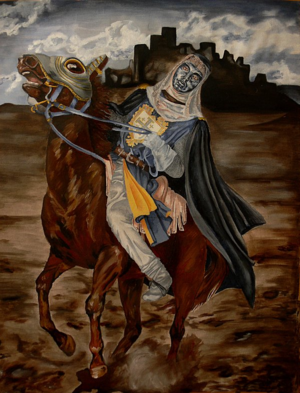Vovoide Ivan II
| Ivan II | |
|---|---|
| Vovoide | |
 A portrait of Ivan during the Orthodox Crusades. | |
| Reign | August 1531 – 28 April 1569 |
| Born | Roughly December c.1514 Sopava, Moldanovica |
| Consort | Vasilica of Dzegad |
| Issue |
|
| Dynasty | Cornea Dynasty |
Ivan II (Moldanian: Ievan, 1514-1569) famously known as Ivan the Masked, was the Vovoide of Mouldania from 1531 to 1569. He was admired by the Moldanians for his dedication to the Principality, as well as his work trying to contain leprosy. Choosing competent advisers, Ivan ruled a thriving realm and succeeded in protecting it from the ambitions of foreign powers such as Ereska and Tiskaiya.
Ivan is most well known for being the 'Masked King' as he was not seen in public without his famous masked helmet past the age of 14. This was due to an apparent horrific injury sustained to his face while jousting that lead to a facial deformity, which would have effected the way the Moldanian people viewed him and his power, as due to societal standards he would have been viewed to be weak and unfit of ruling. Raised heavily with Orthodox beliefs, he lead a crusade into the great plains to spread the branch of Christianity into the region in the first few years of his reign, meeting some resistance from Jovanists near the River Grăşti, raising tensions between the powers.
Childhood and Early Life
Ivan was born at some point in December, 1514. He was the first born son to Sorin of Moldania and Sofia of Cachia in the capital city of Sopava, likely in the Royal Palace. From a young age the spotlight was on the boy, as he was first in line to the throne in a period of religious instability between the Catholic, Orthodox and Jovanist populations. From a young age it was noted that he was much more intelligent that any of his siblings, as well as talented in jousting and sword duelling, which he was taught professionally by swordsman Dominik Iacobescu.
While in a regional jousting competition set up by his father, aged 13, while riding on his horse in a joust he was struck in the face by a blow from the opponent, leaving his face, according to historians, 'very disfigured'.